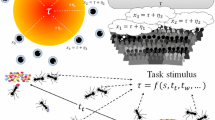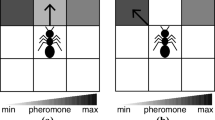Abstract
Task allocation problem has been an issue in multi-agent systems. Among many interesting tasks, we focus on an algorithm for the proportional regulation of population where the swarm is divided into groups depending on task demands. We take the response threshold model inspired by division of labor in several social insects. In our approach, the member proportion of each sub-group is regulated proportional to the external task demands and local social interactions among agents. Here, the interactions control the response thresholds for given tasks. The proposed algorithm was applied to simulation experiments of robots, and the experimental results show that the proposed method has adaptive and robust responses under dynamically changing environments.
Access this chapter
Tax calculation will be finalised at checkout
Purchases are for personal use only
Similar content being viewed by others
References
Gordon, D.: Ants at Work: How an Insect Society is Organized. Simon and Schuster, New York (1999)
Holldobler, B.: Journey to the Ants. A Story of Scientific Exploration, p. 228. Harvard University Press, Cambridge (1994)
Seeley, T.: The Wisdom of the Hive: The Social Physiology of Honey Bee Colonies. Harvard University Press, Cambridge (2009)
Cao, Y.: Cooperative mobile robotics: antecedents and directions. Auton. Robots 4(1), 7–27 (1997)
Beckers, R.: From local actions to global tasks: stigmergy and collective robotics. Artif. life IV 11, 189 (1994)
Kube, C.: Collective robotics: from social insects to robots. Adapt. Behav. 2(2), 189–218 (1993)
Tofts, C.: Algorithms for task allocation in ants. (a study of temporal polyethism: theory). Bull. Math. Biol. 55(5), 891–918 (1993)
Dorigo, M.: Ant algorithms for discrete optimization. Artif. Life 5(2), 137–172 (1999)
Bonabeau, E.: Quantitative study of the fixed threshold model for the regulation of division of labour in insect societies. In: Proceedings of the Royal Society of London. Series B: Biological Sciences, vol. 263, No. 1376, pp. 1565–1569 (1996)
Bonabeau, E.: Adaptive task allocation inspired by a model of division of labor in social insects. In: Proceedings of BCEC, pp. 36–45 (1997)
Theraulaz, G.: Response threshold reinforcements and division of labour in insect societies. In: Proceedings of the Royal Society of London. Series B: Biological Sciences, vol. 265, No. 1393, pp. 327–332 (1998)
Bonabeau, E.: Fixed response thresholds and the regulation of division of labor in insect societies. Bull. Math. Biol. 60(4), 753–807 (1998)
Jung, B.: Tracking targets using multiple robots: the effect of environment occlusion. Auton. Robots 13(3), 191–205 (2002)
Krieger, M.: Ant-like task allocation and recruitment in cooperative robots. Nature 406(6799), 992–995 (2000)
Sundstrom, L.: Sex allocation and colony maintenance in monogyne and polygyne colonies of formica truncorum (hymenoptera: formicidae): the impact of kinship and mating structure. Am. Nat. 146, 182–201 (1994)
Winston, M.: The Biology of the Honey Bee. Harvard University Press, Cambridge (1991)
Huang, Z.: Regulation of honey bee division of labor by colony age demography. Behav. Ecol. Sociobiol. 39(3), 147–158 (1996)
Beshers, S.: Social inhibition and the regulation of temporal polyethism in honey bees. J. Theor. Biol. 213(3), 461–479 (2001)
Gordon, D.: Dynamics of task switching in harvester ants. Anim. Behav. 38(2), 194–204 (1989)
Beshers, S.: Models of division of labor in social insects. Ann. Rev. Entomol. 46(1), 413–440 (2001)
Watanabe, A.: The change of discharge frequency by AC stimulus in a weak electric fish. J. Exp. Biol. 40(1), 57–66 (1963)
Acknowledgements
This work was supported by the National Research Foundation of Korea(NRF) grant funded by the Korea government(MEST) (No. 2014R1A2A1A11053839).
Author information
Authors and Affiliations
Corresponding author
Editor information
Editors and Affiliations
Rights and permissions
Copyright information
© 2016 Springer International Publishing Switzerland
About this paper
Cite this paper
Lee, W., Kim, D. (2016). Local Interaction of Agents for Division of Labor in Multi-agent Systems. In: Tuci, E., Giagkos, A., Wilson, M., Hallam, J. (eds) From Animals to Animats 14. SAB 2016. Lecture Notes in Computer Science(), vol 9825. Springer, Cham. https://doi.org/10.1007/978-3-319-43488-9_5
Download citation
DOI: https://doi.org/10.1007/978-3-319-43488-9_5
Published:
Publisher Name: Springer, Cham
Print ISBN: 978-3-319-43487-2
Online ISBN: 978-3-319-43488-9
eBook Packages: Computer ScienceComputer Science (R0)




